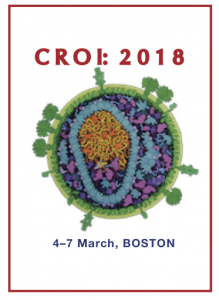Efavirenz might decrease effectiveness of the vaginal contraceptive ring
16 April 2018. Related: Conference reports, Pregnancy, PK and drug interactions, CROI 25 (Retrovirus) 2018.
 Polly Clayden, HIV i-Base
Polly Clayden, HIV i-Base
Efavirenz and atazanavir/ritonavir both alter hormone exposure from the vaginal ring in HIV positive women. But, unlike efavirenz, atazanavir/ritonavir is not expected to have an impact on the ring’s effectiveness. This phenomenon is similar or greater to that previously reported with oral hormonal contraceptives.
These findings from the ACTG 5316 pharmacokinetic (PK) study were presented by Kimberly Scarsi of University of Nebraska Medical Center at CROI 2018.
The vaginal ring (Nuvaring) contains etonogestrel/ethinyl estradiol (ENG/EE) 120/15 mcg/day and provides a month of hormonal contraception. Contraceptive hormones delivered in this way achieve lower concentrations than those with oral or injectable methods but sufficient levels to provide contraception.
Drug-drug interactions (DDI) occur with oral hormonal contraceptives and some antiretroviral therapy (ART). But the impact of ART on hormone exposure from a vaginal ring is unknown.
ACTG 5316 was a phase 2 multicountry, multicentre, non-randomised, parallel group, PK assessment of HIV positive women 16 years old and above with sites in Africa, Asia, South America and North America.
The study evaluated three groups of participants: women not yet receiving ART (control group; n=25); receiving efavirenz (EFV)-containing ART 600mg daily (n=25); and receiving atazanavir/ritonavir (ATV/r)-containing ART 300/100 mg daily (n=24). Women in the control group had CD4 above 350 cells/mm3, the threshold for starting ART at the time the study was conducted. All women consented to use an additional method of contraception during the evaluation.
Participants were approximately 35 years of age (women in the control group were slightly younger than in the two ART groups), 50% black, and 35% Hispanic.
Single PK measurements of ENG and EE were taken on days 7, 14, and 21. Plasma hormone PK exposure was compared between each ART group and the control group.
Compared to the control group, participants in the EFV group had 76–79% lower ENG and 53–57% lower EE over 21 days (all comparisons p<0.001).
Participants in the ATV/r group had 71–79% higher ENG (all p<0.001), but 29– 35% lower EE (p=0.066, 0.032 and 0.004 at days 7, 14 and 21, respectively) over 21 days compared to the control group.
Approximately 25% of women experienced mild or grade 2 adverse events – these were mostly abnormal vaginal discharge or menstrual irregularities.
The investigators concluded that ATV/r-based ART is unlikely to have an impact on the effectiveness of the vaginal ring but EFV lowered both ENG and EE and might decrease its effectiveness.
comment
The effect of EFV on other methods of hormonal contraception has been well characterised previously – including by excellent work from Dr Scarsi’s group. This inconvenient aspect of EFV is not always considered enough in discussions of optimum ART regimens.
This study highlights the importance of understanding DDI of drugs given by vaginal ring which should be looked at routinely during the development of new technologies.
Reference
Scarsi K et al. Vaginal contraceptive hormone exposure profoundly altered by EFV- and ATV/r-based ART. 25th Conference on Retroviruses and Opportunistic Infections (CROI 2018), 4–7 March 2018, Boston. Oral abstract 141.
http://www.croiconference.org/sessions/vaginal-contraceptive-hormone-exposure-profoundly-altered-efv-and-atvr-based-art (abstract)
http://www.croiwebcasts.org/console/player/37313 (webcast)

